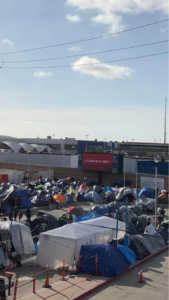Recent reports of “pandemic refugees” arriving at the southern border of the United States draws attention to the question of what is going to happen to these and other migrants who cross into the United States to seek asylum during the Biden administration. Pandemic refugees are coming, according to a New York Times report, “from far-flung countries where the coronavirus has caused unimaginable levels of illness and death and decimated economies and livelihoods.” This includes, in addition to established flows from Mexico, Guatemala, El Salvador, and Honduras, growing numbers from countries such as Brazil, Ecuador, and Venezuela.
The use of the term “refugee,” whether by news media, advocacy groups, or by migrants themselves, implies that these asylum seekers will be eligible to remain in the United States. Yet, this is not likely to be the case for many of them. Why?
WHO IS ELIGIBLE FOR ASYLUM IN THE UNITED STATES?
US immigration law offers asylum to those exhibiting a well-founded fear of persecution due to race, religion, nationality, political opinion, or membership in a particular social group. Asylum law was not designed to be a remedy for poverty, unemployment, climate disaster, domestic violence, or public health emergency. Migrants who try to make cases in court on these grounds are likely to fail, and an unsuccessful asylum process will normally end in deportation to the country of origin. Migrants, however, are often unaware of this outcome and believe that it will be enough just to reach the US border and make their plea.
Many migrants in transit through Mexico who have recorded their stories for the University of California, Davis’s Humanizing Deportation digital storytelling project have expressed this belief. A Honduran migrant, nicknamed “El Vato,” who left his homeland “due to the lack of employment,” explains in a digital story recorded in Ciudad Juárez in 2019 that he couldn’t afford basic school supplies to send his son to kindergarten. A brother who lives in Houston encouraged him to migrate. El Vato reasons: “I want to give my son a future,” but confesses, “if they don’t give me asylum, I don’t know what [I’ll do].”
The prospects for many are bleak. The first step for asylum seekers who turn themselves in at the border is a “credible fear interview.” Any migrant who does not convince the immigration officer that they face the threat of persecution in their home country may be subject to immediate deportation. For those who are allowed to go ahead with the often lengthy asylum application process, including background checks and multiple immigration court hearings, which normally stretches on for many months, or sometimes years, success rates, which vary widely by country of origin, are often lower than people realize. In 2020, for example, positive outcomes for the four nations with the largest number of asylum seekers (Guatemala, El Salvador, Honduras, and Mexico) ranged from 12.7% to 18.1%. Figures are even more bleak for those who are denied at the outset, through their credible fear interviews. Furthermore, very few asylum seekers from these countries obtain legal residence in the United States.
Moreover, the Title 42 order issued by the Centers for Disease Control in March of 2020 in order to contain the spread of COVID-19 allows US immigration officers to immediately expel migrants apprehended at the Mexican or Canadian border, including asylum seekers. Migrants may be sent directly back to their countries of origin, while migrants from Guatemala, El Salvador, and Honduras have been routinely sent back to Mexico. Currently only unaccompanied minors and a limited number of other asylum seekers are being admitted to the United States and allowed to initiate asylum applications.
US asylum law was written in response to the tragedy of World War II, when the United States had denied entry to tens of thousands of Jews attempting to flee persecution in Europe. During the Cold War years, it readily accommodated pro-democracy political dissidents from communist countries. However, it has never been revised to offer relief to migrants whose homes are destroyed by natural disasters, who flee violent threats from organized crime syndicates, or who fear contagion of deadly illness in the context of inadequate or dysfunctional public health infrastructure.
The use of the term “refugee,” whether by news media, advocacy groups, or by migrants themselves, implies that these asylum seekers will be eligible to remain in the United States. Yet, this is not likely to be the case for many of them.
What the United States has offered on occasion has been a Temporary Protected Status (TPS) to migrants fleeing conditions such as civil war, climate disasters, or “other extraordinary and temporary conditions” that put them in imminent danger in their homeland. This program offers temporary protection from removal and work authorization to migrants that arrived from certain countries during defined time periods. TPS offers no path to permanent residence or citizenship; indeed, this status is meant to expire as soon as return to the home country is viable. In practice, however, TPS may be extended for years. While some TPS programs have offered only short term relief — for example, a program responding to an Ebola outbreak in Sierra Leone ran from 2014 through 2017 — others have been extended for decades, including one offering safe haven for civil war refugees from Somalia, which has been in effect since 1991. The most recent TPS program, signed into law in March by President Joe Biden, offers relief to Venezuelans suffering from such conditions as “deepening poverty,” “a severely weakened medical system,” and “crime and violence.” The order even mentions “the impact of the COVID-19 pandemic,” implying that the United States welcomes “pandemic refugees” from Venezuela, with the caveat that the program applies only to Venezuelans already in the country in March of 2021. In other words, new arrivals are not eligible.
Those arriving now, including Venezuelans, remain subject to Title 42 expulsions, and those that do get admitted as asylum applicants will enter into the same system that rejects that vast majority of applicants from the countries arriving at the US southern border. With Title 42 in effect now for over a year, large numbers of migrants, including those Mexicans and Central Americans who have faced expedited removal, and migrants from all over who are afraid to cross and be subjected to immediate expulsion, are waiting in border cities for a chance to cross and claim asylum. Meanwhile, there are urgent cases of migrants who may face immediate dangers and are left waiting along with everyone else, exposed to unsafe and unhealthy conditions at the border. A migrant camp at the Tijuana border “is growing increasingly dangerous […] with unsanitary conditions, drug use, and gangs entering the area.” The photo below is from March 2021 and was been taken by activist and photographer Gaba Cortés. 
A female migrant from Honduras, who arrived in Tijuana with the caravan of late 2018, had to sneak away from her home when her daughters’ father got involved with a drug gang and began treating her violently. She lost her home and her business. When describing her experience, she summed it up as follows: “The narcos took everything from me.” She managed to establish a new life elsewhere in Honduras, with a new partner, but her ex- came looking for her. When he found her, he took away their daughters and wouldn’t let her see them. He even beat her and threatened her with a gun. She fled again, this time getting as far as Tijuana.
Is she a refugee? US asylum law does not easily accommodate cases like hers, which is not one of religious or political persecution. Like pandemic migrants, those fleeing domestic violence do not see optimistic prospects in US asylum courts. And there has been no talk of granting TPS — a concept that is more open to explicitly covering COVID-19 dangers or gender violence — to Honduras, Mexico, or other nations with large numbers of asylum applicants and low rates of success. Whether due to the border closure, or to pessimism regarding the outcome of a potential asylum case in the United States, she has resigned herself to trying to establish a new life in Tijuana, the city with the sixth highest murder rate in the world in 2020. Yet she feels safer there than she would in Honduras.
REDEFINING THE TERM “REFUGEE”
What do we make of all of this?
In the short term, the vast majority of migrants arriving at the US border, most of whom do not clearly meet US asylum criteria, might be best advised not to apply, especially if they are afraid of what would happen if they got deported back to their homeland. Yet, while indirect deterrence mechanisms like Title 42 have no doubt discouraged some migrants, they have left thousands of others waiting in highly precarious circumstances, leading the United Nations High Commissioner for Refugees to urge the US to resume accepting asylum applications following protocols of international law as soon as possible.
In the longer run, the United States must streamline its asylum processing, as the current administration has proposed, in order to ensure that applicants can apply for asylum in safe circumstances, and get prompt answers to their claims. But in order to unclog the system of so many claims that are unlikely to succeed, the United States must either do a better job of communicating its definition of “refugee” and its criteria for asylum to migrants before they reach the United States, or broaden these criteria in order to better account for the perilous and often desperate circumstances faced by contemporary asylum seekers.
Robert McKee Irwin is the deputy director of the Global Migration Center at the University of California, Davis.
The images that appear in the body of this piece are from the Humanizing Deportation Project.
Correction 6/03: This article originally showed a picture of Honduran migrant, nicknamed “El Vato” at the border of Ciudad Juárez. Unfortunately, the Humanizing Deportation Project does not own this picture, and it has been removed.





















